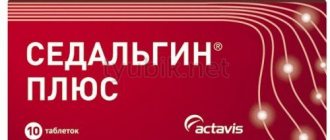Pharmacodynamics and pharmacokinetics
Many people use a combined analgesic and antispasmodic drug - Spazgan, what helps and what the mechanism of action is has been thoroughly studied. It has been established that the active components provide analgesic, antipyretic and mild anti-inflammatory effects.
Thus, metamizole sodium is a non-narcotic analgesic , pitofenone hydrochloride is a myotropic antispasmodic that has a direct effect on the smooth muscles of internal organs, and fenpiverinium bromide is an anticholinergic blocker that complements the relaxing effect. It is in this combination that the pharmacological effects mutually enhance, which reduce elevated body temperature and relieve pain by relaxing smooth muscles.
Pharmacokinetics of metamizole
Resorption is rapid and complete; after 30 minutes, an amount of 5% of the maximum serum concentration is in the bloodstream. Partial binding to plasma proteins occurs in the bloodstream. In general, the substance in the human body is subject to intense biotransformation, resulting in the formation of active metabolites. Only 3% that is excreted is unchanged metamizole . It has been established that individual components can be excreted in breast milk.
Pharmacodynamics
The drug Spazgan contains:
- Metamizole sodium is a non-narcotic analgesic, a derivative of pyrazolone. It is responsible for relieving pain, reducing temperature, as well as mild anti-inflammatory properties.
- Pitofena hydrochloride is a myotropic antispasmodic agent. Relaxes the smooth muscles of muscle tissue through direct action. The action extends to all internal organs
- Phenpiverinium bromide is the main choline blocker. An accompanying quality is a weak relaxing effect on muscle tissue.
These three substances, when combined, enhance the pharmacological properties of each component and contribute to the rapid relief of pain, relaxation of smooth muscles, and active reduction of high body temperature.
Indications for use of Spazgan
- reduction of pain after surgical or diagnostic interventions;
- reduction of increased body temperature in patients with colds or infectious and inflammatory diseases .
Indications for the use of Spazgan for mild or moderate pain syndrome are:
- intestinal spasms;
- spastic state of internal organs;
- biliary or renal colic;
- dysmenorrhea;
- joint pain;
- symptomatic treatment for neuralgia , myalgia , sciatica .
Attention!
Do not use the drug to relieve abdominal pain until the cause of its occurrence is determined.
Indications
Spazgan for injection
A spasm can occur even in a practically healthy person. It depends on the characteristics of the body, or its predisposition to a particular type of disease. The etiology of spasm is the involuntary contraction of muscle tissue of internal organs. Spasm always occurs accompanied by severe pain. Renal, intestinal, or gastric colic are antispasmodic phenomena of internal organs.
Acute pain accompanies inflammatory processes, both in biliary and urolithiasis. The pain is long lasting. To avoid painful shock, the patient needs to take a fast-acting painkiller. Such a remedy is Spazgan. Indications for use of the drug are any acute manifestation of pain with the exception of appendicitis.
The product is endowed with medicinal qualities. It not only situationally combats acute attacks of spasms, but also prevents their further occurrence, fighting the root cause of their manifestation. Spazgan is prescribed in a course of tablets or in the form of injections for 3 to 5 days. After receiving a course of Spazgan, almost all patients noted an improvement in their well-being and the absence of recurrent pain.
Contraindications
Metamizole sodium , pitofenone hydrochloride , fenpiverinium bromide are included in Spazgan tablets. What are they contraindicated for:
- with hypersensitivity to pyrazolone (including Butadione , Tribuzon ) and other components of the drug;
- with severe functional disorders of the kidneys or liver;
- with tachyarrhythmia ;
- in the absence of glucose-6-phosphate dehydrogenase ;
- with angle-closure glaucoma ;
- with prostatic hypertrophy leading to urinary retention ;
- for gastrointestinal obstruction ;
- with megacolon ;
- in the presence of various diseases of the blood system;
- patients in a collaptoid state ;
- pregnant women in the first trimester and the last 6 weeks;
- nursing mothers;
- children under 5 years old.
Indications and contraindications
Analogue of Spazgan - Spazmalgon
Spazgan is prescribed symptomatically - in cases of sudden onset of pain, as well as during general therapy to prevent the occurrence of spasms. For stomach, intestinal and kidney colic of mild to moderate nature. For spasms of intestinal smooth muscles, painful periods and in cases of functional or organic dysmenorrhea. Spazgan is prescribed symptomatically in cases of short-term manifestations of pain symptoms due to sciatica, neuralgia, myalgia, bursitis and arthritis.
As an adjuvant, Spazgan is prescribed to patients after surgery, as well as for certain types of diagnostics to relieve pain and for biliary dyskinesia. As the main therapy for spastic conditions of internal organs, hyperthermia, manifestations of severe forms of migraine.
It is not recommended to take the drug in case of any form of intolerance to any of the components. The drug Spazgan is especially contraindicated for people who have difficulty tolerating pyrazolone derivatives. Contraindications exist for patients with impaired liver function and those suffering from renal failure.
General contraindications:
Side effects
- allergic reactions , manifested in the form of skin rash , itching anaphylactic shock develops ;
- tachycardia , dizziness , decreased blood pressure , cyanosis ;
- Isolated cases of epigastric burning, dry mouth and headache have been reported;
- with prolonged use, the anticholinergic effect can lead to fainting and impaired accommodation ;
- long-term therapy can lead to disorders of the blood system, for example, thrombocytopenia , leukopenia , agranulocytosis ;
- Patients prone to bronchospasm must beware of the risk of provoking an attack.
Instructions for use of Spazgan (Method and dosage)
It is recommended to take the tablets after meals, orally. Dosage regimen: 1-2 tablets up to 3 times a day.
The maximum daily dose is 6 tablets.
Duration of therapy is up to 5 days, otherwise monitoring of peripheral blood parameters and assessment of the functional state of the liver is required.
Spazgan tablets, instructions for use in children
Use is possible only as prescribed by a doctor. The dosage differs depending on the age of the child:
- from 6 to 8 years - no more than 0.5 tablets;
- 9–12 - you can give 3/4 tablets;
- adolescents 13–15 years old are prescribed 1 tablet. up to 3 times during the day.
With intravenous or intramuscular administration of Spazgan solution
- patients with acute severe colic: 5 ml is administered slowly intravenously over 5-8 minutes, if necessary, repeated administration is allowed after 6-8 hours;
- standard single dose – no more than 2 ml;
- the maximum permissible daily dose is no more than 10 ml.
Nosological classification (ICD-10)
- K59.8.1* Intestinal dyskinesia
- K82.8.0* Dyskinesia of the gallbladder and biliary tract
- M25.5 Joint pain
- M54.3 Sciatica
- M79.1 Myalgia
- M79.2 Neuralgia and neuritis, unspecified
- N23 Renal colic, unspecified
- N94.6 Dysmenorrhea, unspecified
- R10.4 Other and unspecified abdominal pain
- R25.2 Cramp and spasm
- R50.0 Fever with chills
- R52.9 Pain, unspecified
- T88.9 Complication of surgical and therapeutic intervention, unspecified
Interaction
- combination with other non-narcotic analgesics causes mutual enhancement of toxic effects;
- with tricyclic antidepressants , oral contraceptives , Allopurinol metabolism in the liver is disrupted and the toxicity of metamizole ;
- with barbiturates , phenylbutazone and other inducers of hepatic microsomal enzymes, metamizole is weakened ;
- with Cyclosporine - the level of the latter in the bloodstream decreases;
- with sedatives and tranquilizers, the analgesic effect of Spazgan is potentiated.
Interaction with other drugs
Spazgan: release form solution in ampoules
When combined with other non-narcotic drugs of the analgesic group, the toxic properties of any of the components of the drug may appear. The risk of a negative effect increases many times over, since each of the components of the drug is in an active pharmacological form, and has a certain reaction with the release of toxins when interacting with other components of analgin-like drugs.
The simultaneous use of Spazgan with contraceptives or tricyclic antidepressants containing allopurinol or codeine can lead to disruption of the metabolism of metamizole in the liver with an increase in its toxicity. Phenylbutazone and barbiturates can weaken the effect of metamizole, increasing its toxicity, and cause adverse reactions. Derivatives of phenylbutazone and barbituric acid inhibit the effect of Spazgan as an antispasmodic agent. When Spazgan interacts with cyclosporines, their bioavailability for the body is blocked with a subsequent decrease in its level in the blood plasma.
When interacting with sedatives or tranquilizers, the effect of Spazgan as an anesthetic is significantly enhanced. Simultaneous use of H1-blockers with histamine, amantadine, tricyclic antidepressants or quinidine, the M-choline blocking properties of Spazgan are significantly enhanced. When interacting with alcohol, the effect is mutually enhanced. Antibiotics of the penicillin group are not used when consuming Spazgan.
Spazgan injections are made without mixing with other agents, since the drug is not compatible with any of them.
Analogs
Level 4 ATC code matches:
Analdim
Reopirin
Tempalgin
Benalgin
Pentalgin ICN
Pentalgin N
Pentalgin
Analgin
Renalgan
Tetralgin
Spasmalin
Maxigan
Sedal-M
Piralgin
Baralgin M
Sedalgin Plus
Baralgetas
Revalgin
Andipal
Spazgan substitutes that match all 3 active ingredients:
- Baralgetas solution and tablets ;
- Realgin solution and tablets ;
- Maxigan tablets ;
- Renalgan and Realgan , Reonalgan ;
- Spazmadol , Spazmalgon , Spasmoblock , Spazmil .
Differences between Spazgan and Spazmalgon
Most often, patients using modern antispasmodics ask the question: which is better Spazgan or Spazmalgon ?
Spazmalgon is a structural analogue of Spazgan, produced in Bulgaria, which is slightly cheaper in price. Due to the same active ingredients and their quantity in 1 tablet, the instructions for use, indications, and contraindications for these drugs are the same. However, on the forums you can find different comments in favor of one or another analogue. But this is more of a personal individual reaction of the body rather than a pattern.
The main difference between Spazgan and Spazmalgon is the price and manufacturer.
Spazgan price, where to buy
The average cost of Spazgan solution (5 ampoules of 5 ml) is 140-150 rubles, while the price of Spazgan tablets differs depending on the number of tablets in the package:
- a package of tablets No. 20 costs approximately 130 rubles;
- pack of tablets No. 100 - approximately 410 rubles.
- Online pharmacies in RussiaRussia
ZdravCity
- Spazgan tablets 100 pcs. Wockhardt
404 rub. order - Spazgan tablets 20 pcs. Wockhardt
RUB 139 order
- Spazgan NEO tablets p.p.o. 400mg+5mg+0.1mg 20pcsWockhard Limited
RUB 188 order
- Spazgan solution for IV and IM injection 500mg/ml+20mg/ml+0.02mg/mlWockhard Limited/Zen Pharma P LTD
RUB 142 order


